Dental Implants – Sparks, NV
Discover the Advantages of Implant-Supported Replacement Teeth
 Dental implants have changed the way we replace missing teeth, giving dentists the ability to restore the entire tooth, not just the visible portions. At Vista Dental Care, we utilize our state-of-the-art
CT/Cone beam scanner
to accurately and precisely plan for the surgical positioning of implant posts into the jaw. That means we’re able to perform the entire procedure – both the surgical implantation and the restoration. If you’d like to find out more about the dental implant process,
contact
our Sparks dentist and team to schedule a consultation. We’ll help you find the best tooth replacement option for your smile.
Dental implants have changed the way we replace missing teeth, giving dentists the ability to restore the entire tooth, not just the visible portions. At Vista Dental Care, we utilize our state-of-the-art
CT/Cone beam scanner
to accurately and precisely plan for the surgical positioning of implant posts into the jaw. That means we’re able to perform the entire procedure – both the surgical implantation and the restoration. If you’d like to find out more about the dental implant process,
contact
our Sparks dentist and team to schedule a consultation. We’ll help you find the best tooth replacement option for your smile.
Why Choose Vista Dental Care for Dental Implants?
- Start-to-Finish Dental Implant Procedures
- Cone Beam Scanner for Accurate Implant Placement
- Compassionate, Knowledgeable Dental Team
What are Dental Implants?
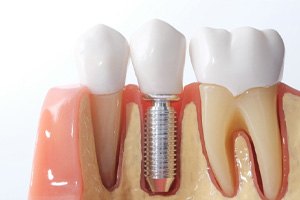
The three main components of a dental implant are the post, the abutment, and the final restoration. By itself, the post looks more like a screw than a tooth. It can be surgically placed into the jaw so that it can gradually join with the surrounding bone. Ultimately, the post will be used to support the final restoration, which is the crown, bridge, or denture that will fill in the empty space in your smile. The abutment is the piece of metal that’s responsible for keeping the restoration attached to the post.
The 4-Step Dental Implant Process

Because Dr. Marc Thomas is dedicated to continuing education in order to provide advanced services for our patients, he has completed training in dental implant placement. Our office also has access to many of the innovative technologies that surgical practices utilize to make implant placement safe and effective. Here’s a brief overview of what the process will ultimately look like.
Initial Dental Implant Consultation
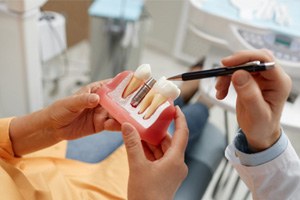
If you have good oral and general health, you are a candidate for dental implants; however, you will require a thorough consultation. In addition to evaluating your dental health, Dr. Thomas will discuss your medical and lifestyle history to look for any potential issues that could lead to late-term implant failure, like immune disorders or smoking.
Diagnostic images will be needed to assess the health of your jawbone. Dr. Thomas will take digital X-rays and use CT scans to gain a complete picture of your oral structures. Based on the information, he may recommend that you undergo additional procedures prior to having the posts placed, such as tooth extractions, bone grafting, or a sinus lift.
Dental Implant Surgery

Using the previous scans and computer-guided technology, Dr. Thomas will be able to pinpoint the ideal location for your implant posts. To insert them into your jawbone, you will require surgery. Anesthesia and/or sedation will be used, so you do not need to worry about feeling any pain or discomfort.
Your gum tissue will be opened to expose your jawbone. Small holes will be drilled into it, allowing the posts to be placed. Finally, your gum tissue will be sutured closed, and the healing process will begin.
Dental Implant Osseointegration & Abutment Placement
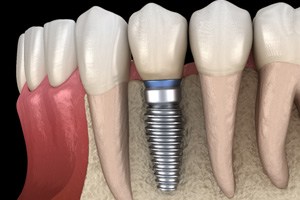
Over the next few weeks, new bone growth will be stimulated, and your jaw will fuse to the posts through a process called osseointegration. Once your jawbone has healed, you will need a second minor surgery to have your abutments placed. During this procedure, your gum tissue will be opened to give Dr. Thomas access to the implants. After the abutments are positioned, your gum tissue will heal around them to create a natural-looking gumline.
Delivery of Dental Implant Restorations
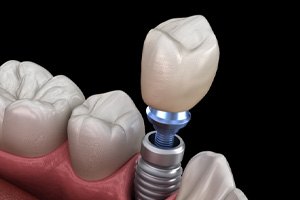
To fill the empty spaces in your smile, digital impressions will be needed to design your restoration, such as a crown, bridge, or denture. It will be created with accuracy to meet your exact needs. Made from high-quality, durable materials, it will last for several years with the right care. It will also look natural, so no one will be able to tell that they are not your real teeth. The completed restoration will be attached to your dental implants during one last appointment.
Who Dental Implants Can Help

As long as your mouth is in good health, there’s a pretty good chance that you can have the gaps in your grin filled with sturdy dental implants. Depending on the number and location of missing teeth, the kind of dental implant restoration used can vary. Typically, we recommend one of the following options:
Missing 1 Tooth
To replace one tooth, we can anchor a crown to one implant post. We may be able to fuse two crowns together and attach them to one implant post to replace two missing teeth.
Missing Multiple Teeth
When patients are missing numerous consecutive teeth, we can use an implant post at each end of a fixed bridge to support the tooth replacement prosthesis.
Missing All Teeth
Like their traditional counterparts, implant dentures use a gum-colored base material to support numerous replacement teeth up to a full arch, and they can typically be anchored using four to six implant posts.
Implant Dentures
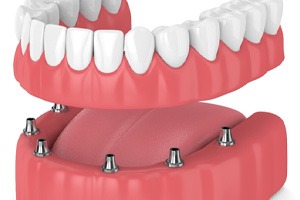
If you’ve experienced advanced tooth loss, a partial or full denture supported by dental implants may be your best option. Like traditional partial and full dentures, implant dentures utilize a base material to support numerous missing teeth. Where traditional dentures are anchored to surrounding teeth or utilize suction between teeth and gums for support, your implant denture will be naturally supported by three to six dental implant posts that replace missing tooth roots. This recreates your lost teeth, creating a seamless, natural appearance and long-lasting stability.
All-on-4
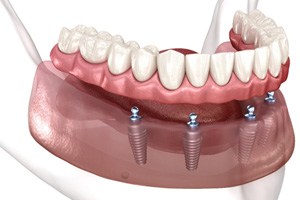
With All-on-4 dental implants, Dr. Thomas can replace an entire arch of teeth with as few as four dental implants. They’re placed at strategic positions throughout the jaw, in areas where the bone is naturally thick and strong. After the implants are inserted, you’ll immediately receive a provisional denture. All-on-4 is a remarkable procedure that offers many of the benefits of traditional dental implants, including a strong bite and a confident, beautiful smile.
Understanding the Cost of Dental Implants

Dental implants allow you to make a long-term investment in your smile and your quality of life. When determining how much your treatment will cost, there are various aspects that influence the amount you will have to pay. To help keep your procedure affordable, there are several payment options you can use, such as your dental insurance and CareCredit.
Preliminary Treatments & Dental Implant Surgery
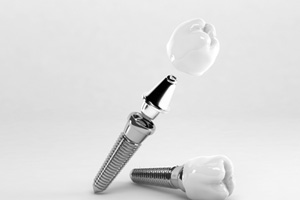
It is not uncommon to need tooth extractions, bone grafting, or a sinus lift prior to placing your posts. Naturally, you will need to pay for these procedures separately. Then, when it comes to the surgery itself, the cost will be influenced by a number of factors, including whether sedation or anesthesia is used to help you stay comfortable during the procedure. The good news is that you won’t need to worry about being billed by a different practice since our team will handle every step of the dental implant process.
The Parts of Your Dental Implant
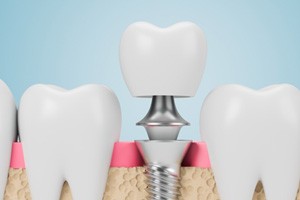
There are various aspects of your treatment that will influence the price, such as:
- Number of Teeth: A single implant post is cheaper than multiple implant posts; however, replacing several teeth with a bridge or denture is more affordable than treating each tooth individually.
- Abutments: If more than one is needed, the price will increase.
- Materials: The types of posts and restorations that are used impact the cost, such as if mini dental implants are used instead of traditional posts.
How Dental Implants Can Save You Money

Although you will spend more upfront than with traditional options, dental implants are more affordable long-term because they have the potential to last for a lifetime. You will not need to have them replaced in the future if you care for them properly. On top of that, filling in the gaps in your grin can lower your risk for oral health issues associated with missing teeth, meaning you can avoid problems that might require paying for additional treatments.
Does My Dental Insurance Cover Dental Implants?

Most insurance policies do not cover the cost of the procedure in full, but they may pay for certain aspects, like the anesthesia or the final restoration. Don’t forget to review your plan so that you can get an idea of what your benefits look like and how they can be used to make paying for your dental implants easier. You can always speak to our team if you have any dental insurance questions, and we can file claims for you if need be.
Making Dental Implants Affordable

Do not let the cost of dental implants discourage you from completing your smile. There are several payment options available to cover any out-of-pocket expenses, like third-party financing with CareCredit. The big advantage of financing is that it breaks up the cost of your treatment into a number of monthly installments. On top of that, CareCredit plans come with little to no financing to worry about. Please let us know if you’re interested in pursuing financing to help pay for dental implants.
Dental Implant Technology
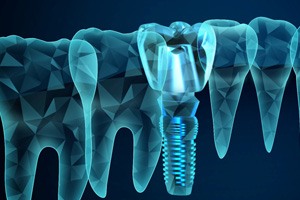
We utilize a wide range of state-of-the-art dentistry techniques and technologies in order to make the services we offer faster, safer, and more effective for every patient who visits. When we provide complex dental treatments like dental implants, it makes sense that we would rely on all the most innovative strategies at hand to ensure the ideal end result. Below, we’ll discuss some of the high-tech tools we utilize to create seamless dental implant tooth replacement plans to put the smile back on your face.
CT/Cone Beam Scanning
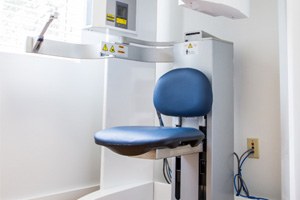
The key to our precise dental implant tooth replacement planning is the use of 3D CT cone beam scans. Unlike traditional X-rays that only allow us to see a two-dimensional image of one section of the smile, our CT cone beam scanner can give us a 360-degree view of one tooth or your entire smile. When we’re planning a tooth replacement procedure, this is essential. It ensures we see the way that your new tooth or teeth will impact your bite and aids us in creating a flawless-looking and functioning restoration, so you can speak, chew, and smile with total confidence in every situation.
Digital Bite Impressions

In addition to our advanced, three-dimensional X-rays, we also utilize digital bite impressions. These are used by our dental lab to create your replacement tooth or teeth. In the past, we needed to capture impressions in putty and mail them to the dental lab. This process not only takes longer but also increases the risk of human error. Digital impressions precisely capture every pit and groove in your prepared smile. Then, we can instantly transfer the impressions to our trusted dental lab so they can get started creating your replacement tooth or teeth immediately.
Same-Day Restorations with CEREC
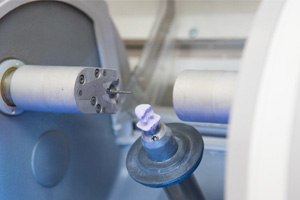
In addition to advanced treatment technology to improve the planning process and dental lab communication, we also use the state-of-the-art CEREC system to create replacement teeth in just one appointment. CEREC allows us to perform the entire design and crafting process for dental restoration right here in our office. That means you can have a brand new, custom dental crown or bridge on the same day your abutments are placed.
Advanced Dental Implant Procedures

Many patients understand that replacing missing teeth with a dental implant supported restoration is going to be a lengthy and complex process. What they may not know is that the dental implant placement procedure can be just one of several complex treatments that are necessary as part of the overall tooth replacement plan. In addition to dental implant placement, you may also need one or more advanced preparatory services like bone and soft tissue grafts or tooth extractions. These procedures are often necessary to improve a patient’s chances for successful dental implant placement and restoration.
Soft Tissue Grafts

A soft tissue graft is one of the services we may recommend prior to implant placement or after. We may use these tissue grafts to build supportive structures to ensure successful implantation. We can also use a soft tissue graft to improve the appearance of the smile if gums become thinner over time and reveal the dark-colored implant structure below.
Bone Grafts
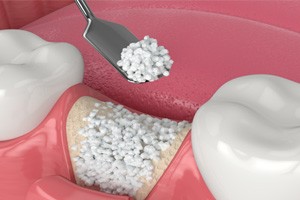
For patients who have experienced diminished jawbone density following tooth loss, we may recommend a bone graft. These grafting procedures build up the height, width, or density of supportive jawbone structure, improving chances for successful dental implant placement. There are a variety of different types of bone grafting procedures available based on each patient’s unique needs.
Sinus Lifts
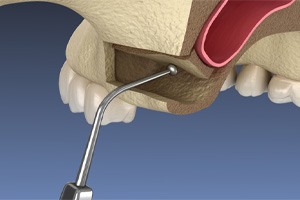
Easily the most common type of bone grafting procedure, a sinus lift is used to diminish the open space in the sinus to improve the chances of successful implantation into the top of the jawbone. By adding bone tissue to lift this sinus gap, patients have a dramatically increased chance of successful upper jaw tooth replacement.
Dental Implant Failure & Salvage
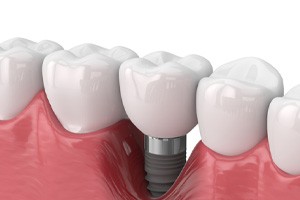
We’ll typically take every precaution to ensure that your dental implants are a success, but complications can still occur even with the best preventive care. If an infection or an injury causes your implants to fail, call us as soon as you can so we can narrow down the cause and figure out the best way to go about treatment. Once we’re sure that the mouth is healthy and that the jaw is ready to support implant posts, we can attempt the surgery again.
Maintaining & Caring for Your Dental Implants

Your new smile can last for a lifetime if you care for it properly over the years. The biggest threat to the longevity of dental implants is an infection that is similar to gum disease. You can keep your smile infection-free and ensure it lasts for decades using the best oral hygiene habits.
Make Oral Hygiene a Priority

Dental implants are not subject to tooth decay; however, any remaining natural teeth can still develop cavities. To keep them healthy, it is vital you brush and floss daily. This also removes harmful food particles and plaque that can lead to odors and an infection known as peri-implantitis.
It is best to use a soft-bristled toothbrush and nonabrasive toothpaste to clean all surfaces of your teeth, your restorations, and your tongue for at least two minutes twice a day. Clean in between each tooth, around the abutments, and the posts daily using high-quality floss.
Protect Your Dental Implants
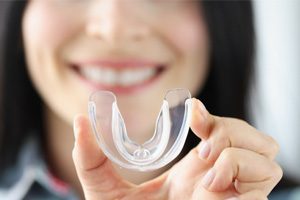
Dental implants are made from a durable material that allows them to withstand the pressure of regular chewing. Unfortunately, they can still become damaged. To protect your new smile, it is best to wear an athletic mouthguard if you participate in any sports. If you have a habit of grinding or clenching your teeth, ask your dentist in Sparks about getting a mouthguard.
It is also best to avoid using your teeth as tools to open packages. Do not chew on inedible objects, like pens, pencils, or your fingernails.
Schedule Regular Dental Checkups

Preventive dental care is crucial to promoting the longevity of your new smile. Besides letting us remove any harmful accumulations of plaque and tartar, it also allows us to monitor your oral health. We can detect any areas of concern sooner and quickly intervene to reduce the risk of late-term implant failure. It is recommended you schedule an appointment for a cleaning and checkup at least twice a year.
Dental Implant FAQs
Before you begin a complex procedure like implant tooth replacement with our team, we encourage you to take the time you need to get answers to all of your questions. Below, you’ll find answers to some of the questions we hear most often. This is not a comprehensive list, so please feel free to call our team to get more information or schedule an appointment at our Sparks dental office.
